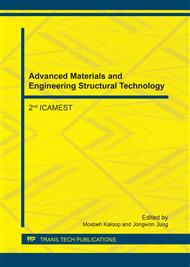p.192
p.202
p.206
p.212
p.218
p.224
p.231
p.237
p.242
Ultrasonic Estimation of Volume Fraction of Kelvin Structure Using Micro-Structural Model
Abstract:
A quantitative ultrasound (QUS) method is developed for estimation of volume fraction of porous Kelvin structure to understand acoustic characteristics of trabecular bone. A Kelvin cellular specimen composed of isotropic tetra-kaidecahedron was produced by 3D printer with ABS plastic material to simulate artificial trabecular bone. The unit cell of Kelvin specimen has a size of 3.4mm and 81% of porosity. The specimen was completely filled with paraffin wax as a substitute of bone marrow. The speed of sound (SOS) of the wax-filled Kelvin specimen was measured using the time-of-flight (TOF) of ultrasound. Based on micro-structural model, shape parameters of Kelvin specimen is correlated with SOS and elastic constant to evaluate volume fraction of the specimen quantitatively. 25.8% of volume fraction was estimated for the Kelvin specimen which has actual volume fraction of 19%. It is concluded from experiment that the ultrasonic method developed in this study is effective and can be applied to diagnose and monitor osteoporosis.
Info:
Periodical:
Pages:
218-223
Citation:
Online since:
April 2017
Authors:
Price:
Сopyright:
© 2017 Trans Tech Publications Ltd. All Rights Reserved
Share:
Citation:


